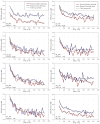Effects of cross-modal selective attention on the sensory periphery: cochlear sensitivity is altered by selective attention
- PMID: 22871520
- PMCID: PMC3471141
- DOI: 10.1016/j.neuroscience.2012.07.062
Effects of cross-modal selective attention on the sensory periphery: cochlear sensitivity is altered by selective attention
Abstract
There is increasing evidence that alterations in the focus of attention result in changes in neural responding at the most peripheral levels of the auditory system. To date, however, those studies have not ruled out differences in task demands or overall arousal in explaining differences in responding across intermodal attentional conditions. The present study sought to compare changes in the response of cochlear outer hair cells, employing distortion product otoacoustic emissions (DPOAEs), under different, balanced conditions of intermodal attention. DPOAEs were measured while the participants counted infrequent, brief exemplars of the DPOAE primary tones (auditory attending), and while counting visual targets, which were instances of Gabor gradient phase shifts (visual attending). Corroborating an earlier study from our laboratory, the results show that DPOAEs recorded in the auditory-ignoring condition were significantly higher in overall amplitude, compared with DPOAEs recorded while participants attended to the eliciting primaries; a finding in apparent contradiction with more central measures of intermodal attention. Also consistent with our previous findings, DPOAE rapid adaptation, believed to be mediated by the medial olivocochlear efferents (MOC), was unaffected by changes in intermodal attention. The present findings indicate that manipulations in the conditions of attention, through the corticofugal pathway, and its last relay to cochlear outer hair cells (OHCs), the MOC, alter cochlear sensitivity to sound. These data also suggest that the MOC influence on OHC sensitivity is composed of two independent processes, one of which is under attentional control.
Copyright © 2012 IBRO. Published by Elsevier Ltd. All rights reserved.
Figures




Similar articles
-
Cognitive task demands modulate the sensitivity of the human cochlea.Front Psychol. 2012 Feb 13;3:30. doi: 10.3389/fpsyg.2012.00030. eCollection 2012. Front Psychol. 2012. PMID: 22347870 Free PMC article.
-
Interaural attention modulates outer hair cell function.Eur J Neurosci. 2014 Dec;40(12):3785-92. doi: 10.1111/ejn.12746. Epub 2014 Oct 10. Eur J Neurosci. 2014. PMID: 25302959 Free PMC article.
-
Efferent-mediated reduction in cochlear gain does not alter tuning estimates from stimulus-frequency otoacoustic emission group delays.Neurosci Lett. 2014 Jan 24;559:132-5. doi: 10.1016/j.neulet.2013.11.059. Epub 2013 Dec 10. Neurosci Lett. 2014. PMID: 24333175
-
Olivocochlear efferents: anatomy, physiology, function, and the measurement of efferent effects in humans.Ear Hear. 2006 Dec;27(6):589-607. doi: 10.1097/01.aud.0000240507.83072.e7. Ear Hear. 2006. PMID: 17086072 Review.
-
Olivocochlear efferents: Their action, effects, measurement and uses, and the impact of the new conception of cochlear mechanical responses.Hear Res. 2018 May;362:38-47. doi: 10.1016/j.heares.2017.12.012. Epub 2017 Dec 21. Hear Res. 2018. PMID: 29291948 Free PMC article. Review.
Cited by
-
The biological role of the medial olivocochlear efferents in hearing: separating evolved function from exaptation.Front Syst Neurosci. 2015 Feb 25;9:12. doi: 10.3389/fnsys.2015.00012. eCollection 2015. Front Syst Neurosci. 2015. PMID: 25762901 Free PMC article.
-
Parametric information about eye movements is sent to the ears.Proc Natl Acad Sci U S A. 2023 Nov 28;120(48):e2303562120. doi: 10.1073/pnas.2303562120. Epub 2023 Nov 21. Proc Natl Acad Sci U S A. 2023. PMID: 37988462 Free PMC article.
-
The eardrums move when the eyes move: A multisensory effect on the mechanics of hearing.Proc Natl Acad Sci U S A. 2018 Feb 6;115(6):E1309-E1318. doi: 10.1073/pnas.1717948115. Epub 2018 Jan 23. Proc Natl Acad Sci U S A. 2018. PMID: 29363603 Free PMC article.
-
Hearing in Complex Environments: Auditory Gain Control, Attention, and Hearing Loss.Front Neurosci. 2022 Feb 10;16:799787. doi: 10.3389/fnins.2022.799787. eCollection 2022. Front Neurosci. 2022. PMID: 35221899 Free PMC article. Review.
-
Effect of Auditory Predictability on the Human Peripheral Auditory System.Front Neurosci. 2020 Apr 15;14:362. doi: 10.3389/fnins.2020.00362. eCollection 2020. Front Neurosci. 2020. PMID: 32351361 Free PMC article.
References
-
- Bassim MK, Miller RL, Buss E, Smith DW. Rapid adaptation of the cubic distortion tone emission in humans: Monaural, binaural and contralateral stimulation effects. Hear Res. 2003;182:140–152. - PubMed
-
- Brown M. Morphology and response properties of single olivocochlear fibers in the guinea pig. Hear Res. 1989;40(1–2):93–109. - PubMed
-
- Cody A, Johnstone B. Acoustically evoked activity of single efferent neurons in the guinea pig cochlea. J Acoust Soc Am. 1982;72:280–282. - PubMed
-
- Dai H, Scharf B, Buus S. Effective attenuation of signals in noise under focused attention. J Acoust Soc Am. 1991;89:2837–2842. - PubMed
Publication types
MeSH terms
Grants and funding
LinkOut - more resources
Full Text Sources

